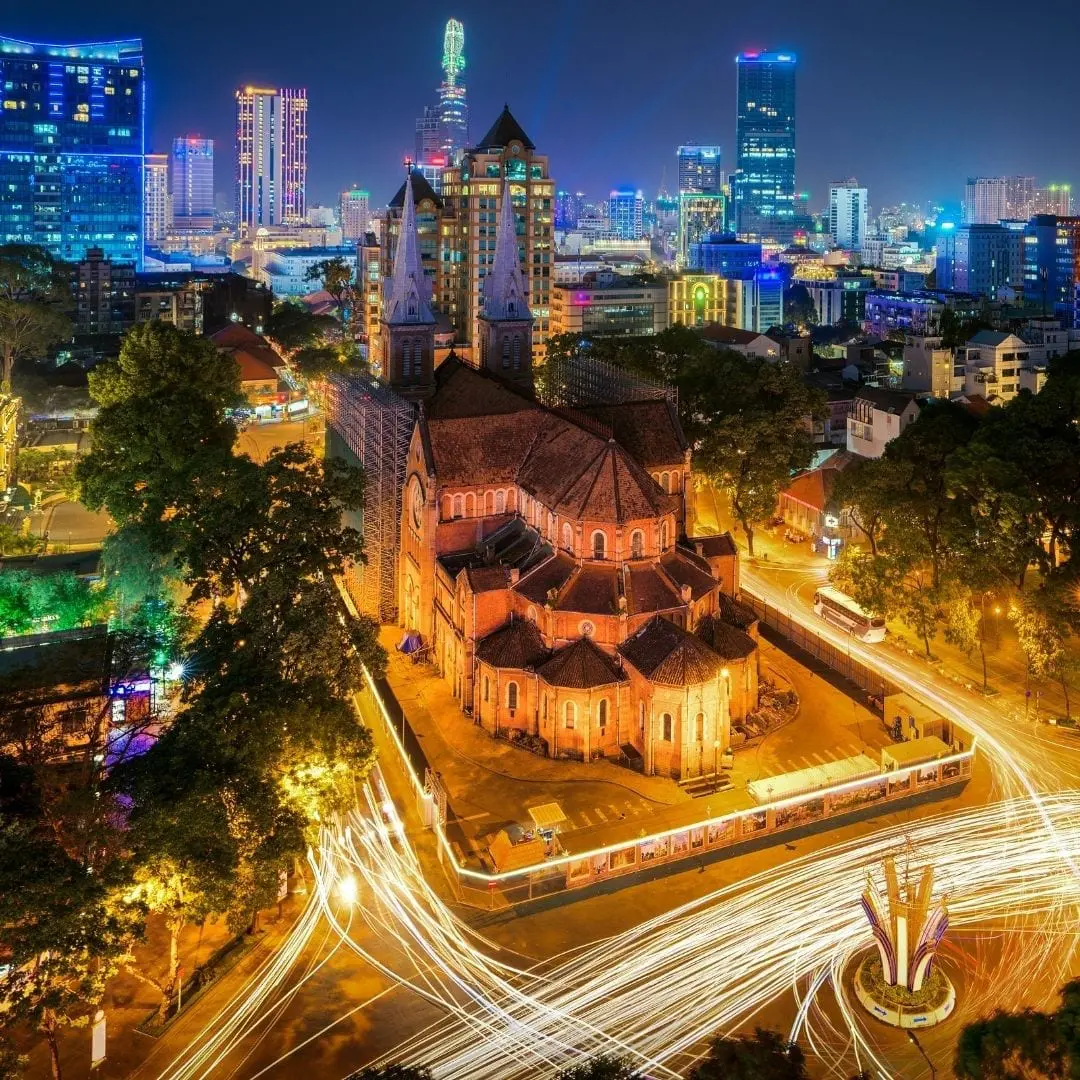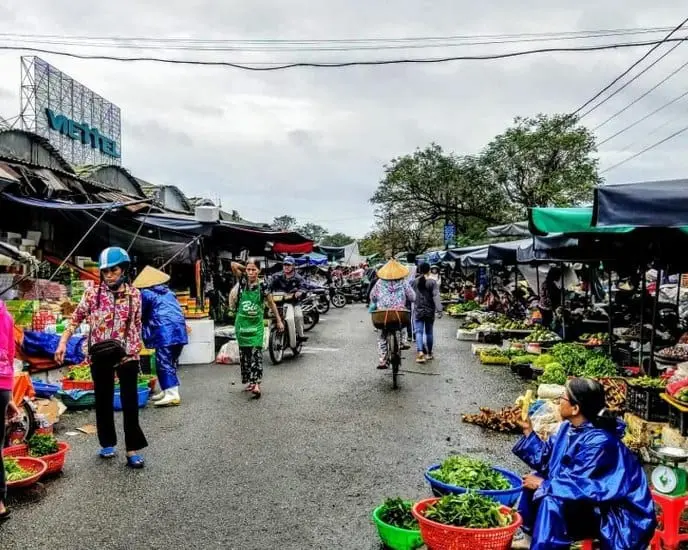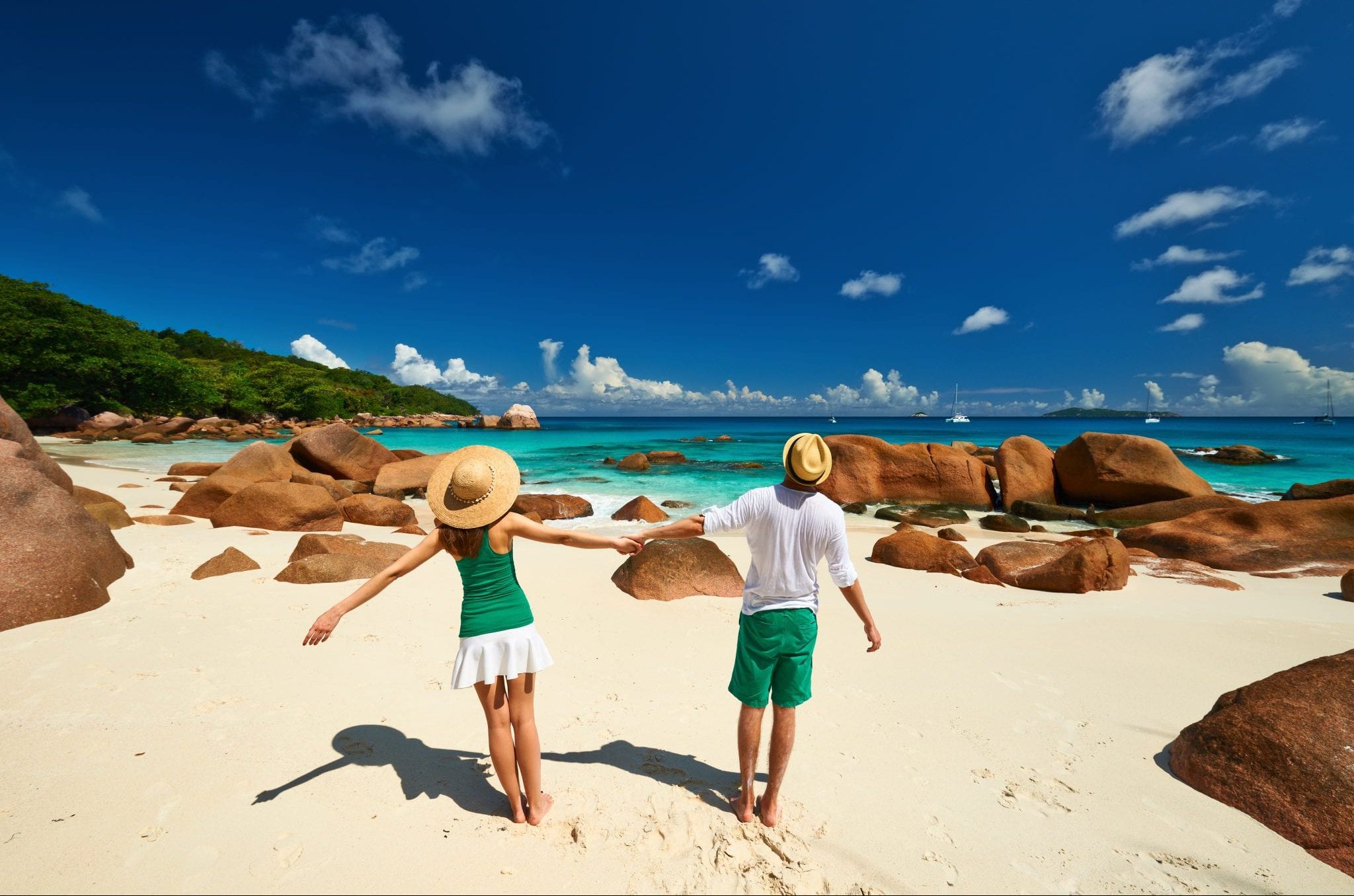Best Places to Visit in Vietnam
A harmonic fusion of nature and human heritage, pristine paddy fields, and an intimate connection with the local culture are what you will find in the best places to visit in Vietnam.

Witness a Big-City Scene Unlike Anywhere Else
The intense Ho Chi Minh City is arguably the first attraction that comes to mind that delivers the chaotic charm of Vietnamese city life. Graceful pagodas remind visitors of where they are amidst a sea of modernistic buildings and humming streets. This is Saigon, once the chief city in Vietnam and the current hotspot for all things cosmopolitan. But if it is profound history that you seek, head to imperial Hue, where history comes in buckets of admiration and awe. Pre-war monuments continue to shape its narrative on the banks of the sensuous Perfume River. Among the best places to visit in Vietnam are the Old Imperial City and Thien Mu Pagoda in Hue. For hidden nods of raw culture wrapped in the rush of city living, Hanoi is the address. Everything is more vivid here, from the frenetic motorbike traffic to the unmissable street food scene.
Unearth the Hidden Cultures of Vietnam
The soul of quintessential Vietnam breathes life in the countryside. Pockets of indigenous cultures and anachronistic practices linger amidst vast rice-terraced plains, beckoning for boundless exploration. Head out into Sa Pa Valley’s medley of villages, fields, and luminous natural corners, and get to know its precious tribes firsthand. Culture is so tangible here in hand-woven carpets and traditional indigo clothes that you will soon lose yourself in its authentic allure. Set foot in the villages of Hmong, Giay, and Red Dzao people, and revel in the joy of becoming a part of their centuries-old daily routine. Miles away on the coast, Hoi An has charm in spades, splintered by canals that lend the city a laid-back charm. It is one of the best places to visit in Vietnam to taste one of its most characteristic historic feats: sea trade.

Visit Southeast Asia’s Postcard Attractions
Beyond spicy cities and rural stretches, Vietnam is famous for spellbinding attractions that befit its spectacular geography. Halong Bay is indisputably the most recognizable of them all, summoning visitors at the country’s northernmost end. It is a fairytale-like spot in itself, with surreal limestone rock pillars soaring above emerald waters. Boat rides on the mystical waters will be the highlight of your Vietnam trip. Another cinematic spot harvesting the country’s epic nature is the Golden Hand Bridge. It is one of the best places to visit in Vietnam to experience its adventurous side. See it for yourself and capture a few insta-worthy shots to take with you.
Must-See Sights in Vietnam
Here is everything you need to know about the best places to visit in Vietnam.

| The Chu Chi Tunnels are part of a massive war museum in Ho Chi Minh. They offer a sneak-peek at the underground life of Vietnamese soldiers back in 1948. |
Why You Should Visit:
Discover the history of Vietnam’s resistance against foreign invaders and experience the underground life of the Vietnamese soldiers who fought in the war.
Don’t Miss:
-Explore the underground tunnels and gain a deeper understanding of the history of the war.
-Take a guided tour with a knowledgeable guide to learn about the significance of the tunnels.
-The Cu Chi Tunnels also offer a shooting range where visitors can try weapons used during the war. While this may not be for everyone, it can provide a unique and thrilling experience.
Keep in Mind:
-Wear comfortable clothing and shoes as the tunnels can be narrow and dark.
-Bring insect repellent as the area is heavily forested and prone to mosquitoes and other insects.
-Be prepared for a potentially claustrophobic experience, as the tunnels are narrow and cramped.

| Dong Ba is the largest marketplace in Hue. It attracts visitors with hearty scenes of daily life, colorful souvenirs, and a variety of fresh produce. |
Why You Should Visit:
Immerse yourself in the vibrant culture of Hue and indulge in local delicacies, traditional handicrafts, and charming souvenirs.
Don’t Miss:
-Try traditional dishes like Bun Bo Hue (a spicy beef noodle soup), Banh Khoai (a savory crepe filled with shrimp, pork, and bean sprouts), and Banh Beo.
-Shop for traditional handicrafts, such as silk scarves, ao dai (Vietnamese traditional dress), and lacquerware.
-Spend a few hours wandering through the market, taking in the sights, sounds, and smells of a traditional Vietnamese market.
Keep in Mind:
-Bargain hard for the best prices, as vendors often inflate prices for tourists.
-Be mindful of your belongings and keep them secure, as pickpocketing can be common in crowded markets.
-Try the local street food, such as banh khoai and bun bo Hue, which are popular dishes in the region.

| Set in the mountains of Vietnam, Golden Hand Bridge is an ultimate allure with the two giant hands lifting it up. It is in a mountain resort famous for its cinematic theme. |
Why You Should Visit:
Admire the breathtaking view of the Ba Na Hills and feel like you’re walking on air as you cross this stunning architectural wonder.
Don’t Miss:
-Walk across the bridge, which offers panoramic views of the surrounding mountains and the sea.
-Take a cable car ride to the top of the mountain to see the Linh Ung Pagoda and the Fantasy Park amusement area, which has rides, games, and a 4D cinema.
-Explore the French Village, take in the views from the bridge, and enjoy the various attractions in the park.
Keep in Mind:
-Get there early in the morning to avoid crowds and get the best views.
-Be prepared for a steep climb up to the bridge, as it is located on top of a mountain.
-Take your time and enjoy the scenery, as the bridge offers stunning views of the surrounding mountains and forests.

| Hanoi is known for its centuries-old architecture and rich culture. At its heart is the chaotic Old Quarter, where the narrow streets are roughly arranged by trade. |
Why You Should Visit:
Explore the capital city’s rich cultural heritage, from ancient pagodas to modern museums, and savor the delicious street food that has made Hanoi famous.
Don’t Miss:
-Wander through the streets of the Old Quarter, sampling local dishes like pho (Vietnamese noodle soup), banh mi (Vietnamese sandwich), and egg coffee.
-Pay respects to Ho Chi Minh and learn about his life and legacy at Ho Chi Minh Mausoleum.
-Attend a traditional water puppet show at the Thang Long Water Puppet Theatre. Water puppetry is a form of folk art that originated in the Red River Delta region of northern Vietnam.
Keep in Mind:
-Be mindful of traffic when crossing the streets, as traffic can be chaotic and drivers may not always stop for pedestrians.
-Try the local street food, such as pho and banh mi, which are popular dishes in Hanoi.
-Visit the Ho Chi Minh Mausoleum, where the preserved body of the former Vietnamese leader is on display.

The port town of Hoi An is most famous for its Venice-like atmosphere with its canals and boasts a well-preserved Ancient Town.
Why You Should Visit:
Step back in time as you wander through the beautifully preserved ancient town, admire the traditional architecture, and shop for handmade silk clothes and lanterns.
Don’t Miss:
-Wander through the pedestrian-friendly streets, taking in the sights and sounds of the town.
-One of the must-see attractions in Hoi An is the Japanese Covered Bridge, a wooden bridge that dates back to the 16th century.
-Visitors can have custom-made clothing created for them, such as suits, dresses, and shoes, at a fraction of the cost of buying ready-made clothing.
Keep in Mind:
-Take a walking tour of the old town to see the well-preserved ancient architecture.
-Get custom-made clothing and shoes from one of the many tailors in the town.
-Try the local cuisine, such as cao lau and white rose dumplings, which are unique to Hoi An.

| The ancient Hue was recognized by UNESCO as one of the World Heritage Sites. This city is the cradle of Vietnamese culture and used to be the national capital. |
Why You Should Visit:
Discover the imperial city’s regal past as you visit the royal tombs, citadel, and ancient temples that make Hue one of Vietnam’s most historic and picturesque destinations.
Don’t Miss:
-Wander through the grounds of the Imperial City, marveling at the intricate architecture and learning about the history of the area.
-A must-see attraction in Hue is the Thien Mu Pagoda, a seven-story pagoda that dates back to the 17th century.
-Take part in a cooking class and learn how to prepare traditional Hue dishes.
Keep in Mind:
-Visit the Imperial City, which was the former seat of the Nguyen Dynasty emperors.
-Take a boat tour of the Perfume River, which offers beautiful views of the city and surrounding countryside.
-Try the local delicacies, such as bun bo Hue and banh khoai, which are popular dishes in the region.

| Sapa is a town in Lao Cai Province. It is located about 350 km northwest of Hanoi, close to the Chinese border, where you’ll find the Hoang Lien Son range of mountains. |
Why You Should Visit:
Trek through the lush green valleys and terraced rice fields of Sapa, meet the local ethnic tribes, and soak in the breathtaking mountain scenery.
Don’t Miss:
-One of the must-do activities in Sapa is trekking through the rice terraces and mountainous landscapes.
-Another must-see attraction in Sapa is the Love Waterfall, a picturesque waterfall located in the Hoang Lien National Park.
-Sapa is also home to several ethnic minority villages, such as the Hmong and Red Dao. Visitors can learn about the traditional lifestyles and customs of these groups by visiting their villages.
Keep in Mind:
-Take a trek to explore the rice terraces and hill tribe villages.
-Be prepared for cooler temperatures, as Sapa is located in the mountains and can be chilly even in the summer months.
-Visit the local markets, which offer a wide variety of handicrafts and local specialties.

| Bordering Cambodia, Chau Doc is a bustling center of trade and river transport. It is a lazy riverside burg, offering a throwback to another time. |
Why You Should Visit:
Explore the bustling floating markets, see the vibrant Cham communities, and take a boat ride to the scenic Sam Mountain for stunning panoramic views of the Mekong Delta.
Don’t Miss:
-Climb to the top of Sam Mountain and visit the various temples and pagodas along the way.
-Take a boat ride on the Mekong River, and see floating houses, local fishing communities, and river markets along the way.
-Visit Tra Su Cajuput Forest, a protected wetland area that offers stunning natural habitats.
Keep in Mind:
-Take a boat tour of the floating markets, where vendors sell fruits, vegetables, and other goods from their boats.
-Visit the Sam Mountain, which offers stunning views of the surrounding countryside and has several pagodas and temples.
-Try the local cuisine, such as fish noodle soup and banh trang nuong, which are popular dishes in the region.
Vietnam FAQ
What are the best places to go hiking and trekking in Vietnam?
Vietnam offers some of the most stunning and varied landscapes in Southeast Asia, making it an excellent destination for hiking and trekking. One of the most popular trekking destinations is Sapa, located in the northern part of the country. This area is home to terraced rice paddies, lush forests, and traditional hill-tribe communities. Other popular hiking destinations include Cat Ba Island in Halong Bay, where you can explore the stunning limestone karst landscapes, and Phong Nha-Ke Bang National Park, which boasts a diverse range of trails and caves to explore.
What are the best places to experience Vietnam’s food culture?
Vietnam is renowned for its delicious and diverse cuisine, which varies by region and is heavily influenced by its neighboring countries. If you want to experience the best of Vietnamese food culture, you should head to the country’s bustling cities, such as Hanoi, Ho Chi Minh City, and Hue. These cities are home to some of the country’s most famous street food markets, where you can sample everything from pho and banh mi to seafood and fresh spring rolls.
What are the best places to visit for a relaxing vacation in Vietnam?
Vietnam offers a wide range of options for travelers seeking a relaxing vacation. Some of the best places to visit include the stunning Halong Bay, known for its picturesque scenery of limestone cliffs and calm waters. Another popular destination is the peaceful town of Hoi An, which boasts a charming old town filled with historic architecture, cozy cafes, and quaint shops. The lush countryside of Sapa is perfect for nature lovers seeking a serene escape from the hustle and bustle of city life.
What are the best places to visit for history buffs in Vietnam?
Vietnam is a country with a rich history that dates back over a thousand years. There are many places to visit for history buffs in Vietnam, but some of the best include Hanoi’s Old Quarter, where you can find many historical sites, such as the Temple of Literature, Ho Chi Minh Mausoleum, and the Hoa Lo Prison Museum. Another must-visit destination is Hue, the former imperial capital of Vietnam, where you can explore the UNESCO-listed Imperial City and the Tomb of Emperor Minh Mang.
What are the best places to shop in Ho Chi Minh City?
Ho Chi Minh City offers a diverse range of shopping experiences, from traditional markets to modern shopping malls. Some of the best places to shop in the city include Ben Thanh Market, which is one of the oldest and most famous markets in Vietnam, and offers a variety of goods such as souvenirs, clothing, and food. Another popular destination is Saigon Square, which is a shopping center with a vast array of clothing, shoes, and accessories at affordable prices. For high-end luxury shopping, visitors can head to Vincom Center, which is a modern shopping mall with a variety of international brands. Dong Khoi Street is also known for its high-end shopping options and designer boutiques.
What are the best ways to explore the Mekong Delta?
The Mekong Delta, located in southern Vietnam, is a fascinating and unique region with a rich cultural heritage and breathtaking natural beauty. One of the best ways to explore this area is by taking a boat tour through the intricate network of canals and waterways that crisscross the delta. This will allow you to see traditional villages, floating markets, and lush rice paddies up close. Cycling is also a popular way to explore the delta, as it allows you to get off the beaten path and see more of the countryside. Finally, don’t miss the chance to sample the delicious local cuisine, which includes fresh seafood, tropical fruits, and aromatic herbs and spices.
What are the top cultural experiences in Hue?
Hue is a city in central Vietnam known for its rich cultural heritage, as it was once the imperial capital of the Nguyen Dynasty. One of the top cultural experiences in Hue is visiting the Imperial City, a UNESCO World Heritage Site that houses palaces, temples, and other important buildings from the dynasty. Another must-see attraction is the Thien Mu Pagoda, a seven-story pagoda located on the banks of the Perfume River. Additionally, taking a cyclo (three-wheeled bicycle taxi) ride through the city’s streets can provide a unique perspective on the local culture and way of life. Hue is also known for its traditional music and dance performances, which can be enjoyed at venues such as the Royal Theatre or in local restaurants.
How many days should I spend in Sa Pa Valley?
The amount of time you should spend in Sa Pa Valley depends on your interests and travel plans. However, a typical itinerary would include at least 2-3 days to explore the valley and its surroundings. This will give you enough time to visit the famous rice terraces, experience the local culture, and take part in various outdoor activities such as trekking and mountain biking. If you have more time to spare, you can extend your stay and explore the nearby villages or take a multi-day trek to other remote areas. Ultimately, it’s up to you to decide how much time you want to spend in Sa Pa Valley and what activities you want to do during your visit.
What are the best things to do in Hoi An for cultural immersion?
Hoi An is a charming ancient town in central Vietnam, known for its well-preserved architecture, rich history, and vibrant cultural scene. To fully immerse yourself in Hoi An’s culture, here are some of the best things to do: 1) Explore the Old Town and its temples, pagodas, and traditional houses; 2) Attend a cooking class and learn to make local dishes like Cao Lau, Mi Quang, and White Rose Dumplings; 3) Take part in a lantern-making workshop and join the famous Hoi An Lantern Festival; 4) Visit the nearby Tra Que Vegetable Village and witness the daily life of local farmers; and 5) Watch a traditional water puppet show and experience the Vietnamese folklore.
 Black Friday: 60% Off
Black Friday: 60% Off Croatia Sailing : Save up to 60%
Croatia Sailing : Save up to 60% Ski Bansko : 60% Off
Ski Bansko : 60% Off Central & Eastern Europe Tours: 60% Off
Central & Eastern Europe Tours: 60% Off  Why Travel Talk
Why Travel Talk Travel Talk Blog
Travel Talk Blog Responsible Travel
Responsible Travel Fair Travels with Travel Talk
Fair Travels with Travel Talk